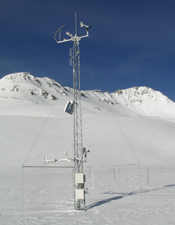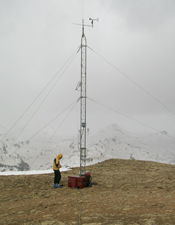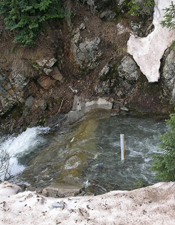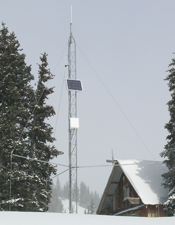CSAS News: October 2009
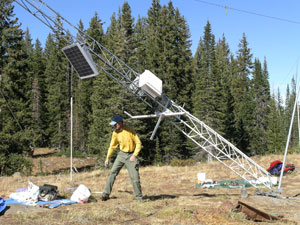 CSAS Installs New Snow Albedo
CSAS Installs New Snow Albedo
Monitoring Tower at Grand Mesa
Dust emissions from the Colorado Plateau have been a focus of study for Dr. Jayne Belnap at the US Geologic Survey’s Southwest Biological Science Center in Moab, Utah for decades. Our more recently emergent Colorado Dust-on-Snow Program recently drew her attention, given our focus on the deposition of desert dust on mountain snowpacks, and it became clear that we could all benefit from additional dust-on-snow monitoring infrastructure located on the Grand Mesa, the world’s largest flat-topped mountain located immediately east and above Grand Junction, Colorado. A Grand Mesa snow albedo monitoring array would, we believed, augment our Senator Beck Basin Study Area monitoring sites by potentially detecting dust events on a more northerly ‘track’ than those affecting the San Juan Mountains.
In spring of 2009 the CSAS’s Chris Landry scouted a site for this new plot and found strong support for the tower and site from the National Weather Service, the Colorado Avalanche Information Center, and Grand Mesa Nordic Council who operate the adjoining Nordic ski trail system. The project permitting process began in June and by late September the US Forest Service had awarded a long-term Special Use Permit for the site thanks to the exceptionally effective and efficient staff at the Grand Valley Ranger District. Meanwhile, Dr. Belnap awarded a small grant for development of the site to Dr. Tom Painter at the University of Utah – Snow Optics Laboratory, our collaborator in the CODOS program, and SOL subsequently subcontracted the CSAS to design and build the 30’ albedo monitoring tower.
Although the Grand Mesa Study Plot does not entirely replicate the extensive array of weather, snowpack, radiation, and soils instrumentation at our Senator Beck Study Plot, the elements of the SBSP array designed to measure snow albedo, snowpack depth, wind speeds and direction, and air temperature and humidity are almost identical at GMSP. Remote communications with GMSP are accomplished through cellular connectivity, a new approach to the CSAS (our sites use traditional radio-to-telephone links). The characteristics of the site, and relatively quick and easy access, on foot, and some luck with weather enabled the CSAS team of Landry and Andrew Temple to just complete the tower base, tower installation, and startup of the instrumentation in mid-October before substantial snowcover developed.
Hour-to-hour data from the Grand Mesa Study Plot (aka Grand Mesa – Skyway) are available to the public via the Colorado Avalanche Information Center’s website at: http://avalanche.state.co.us/obs_stns/stns.php Look for the “Grand Mesa – Skyway Pt” listing under the Grand Mesa heading.
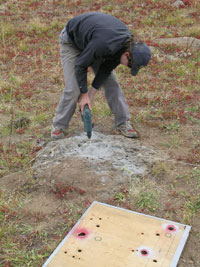
A large basalt boulder provided a solid base for the tower. Andrew is drilling holes into the boulder with a cordless drill for large all-thread studs glued into the rock with epoxy.
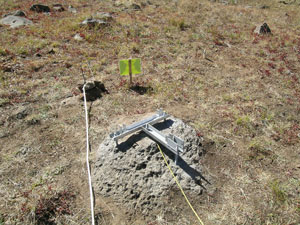
A welded steel base was fastened onto the all-thread ‘studs’ and leveled.
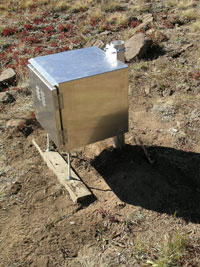
A small enclosure for the photovoltaic system’s battery bank was installed about 40’ from the tower.
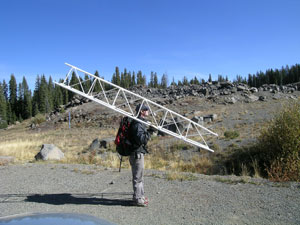
Andrew horsing around at the parking lot with the lower of the three 10’ sections of the 30’ tower, on the way into the site. This section has been painted white to reduce the absorption of solar energy and consequent snowmelt around the tower base.
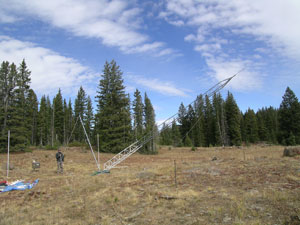
This work day concluded with the assembly of the ‘bare’ tower and raising the tower with a rope winch and gin pole system for the night, ready for instrument array installation the following couple of days.

Two additional, very long days were required to fully outfit the mast with the instrument arrays, datalogger enclosure, wiring, and photovoltaic panel.
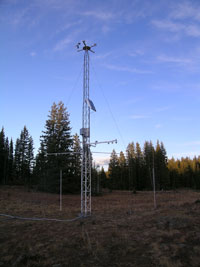
On October 18th the system was powered up and began logging data, at just about sunset.
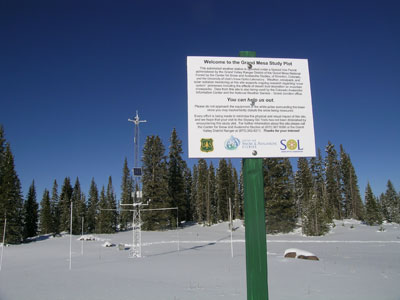
Snowcover soon followed, as seen here on November 16, 2009 and eager early season cross country were surprised to see this new installation next to their Skyway ski trails. Signs explain the intent of the tower and public cooperation, avoiding approaching the tower, has been fantastic. Both the National Weather Service and the Colorado Avalanche Information Center are actively using data from GMSP to monitor weather and avalanche conditions in this unique mountain environment.
<< Previous News Item Next News Item >>




